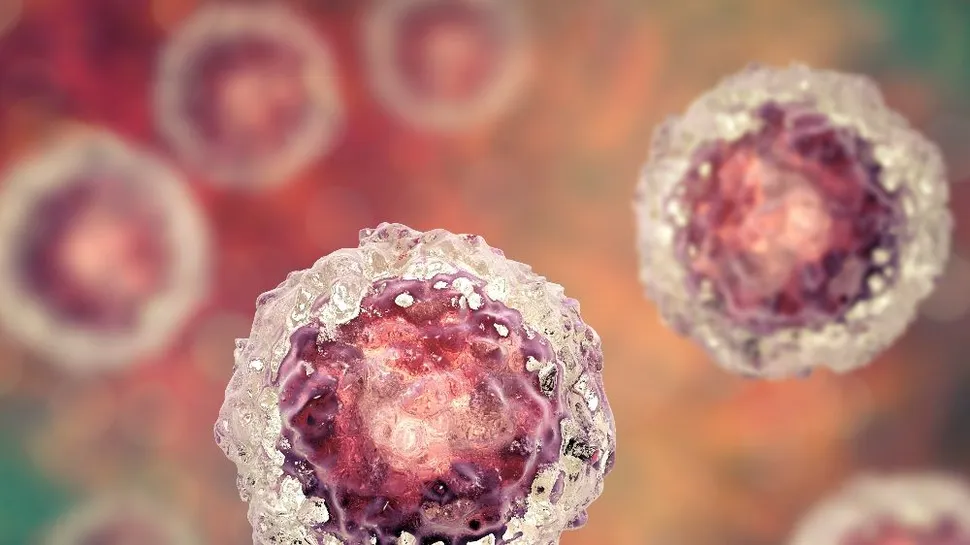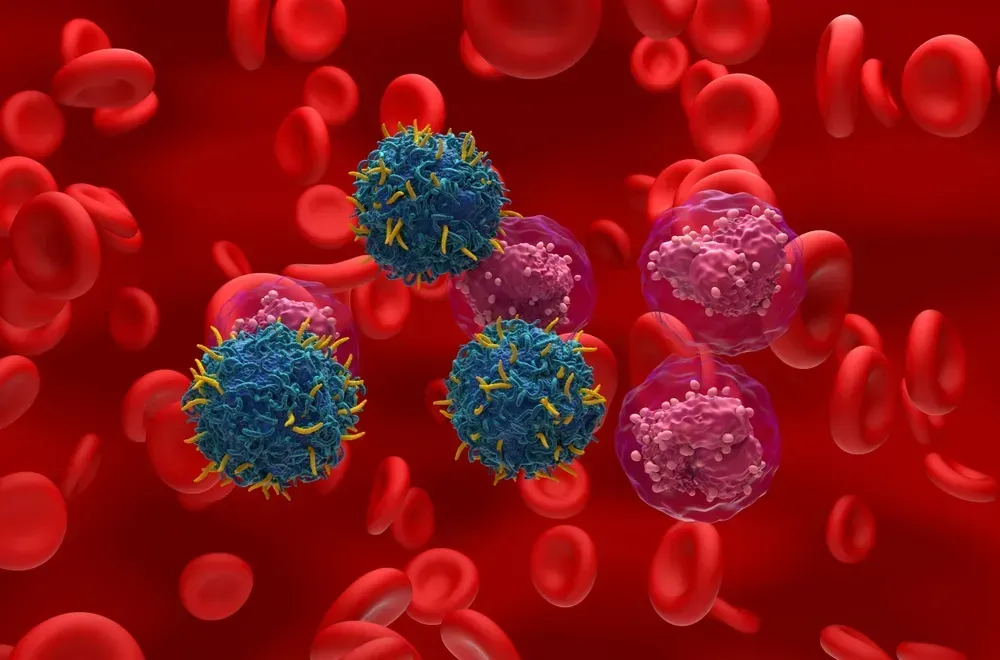Diagnosed With High-Risk Myeloma, What Now?

Multiple myeloma is a blood cancer that develops in plasma cells, a type of white blood cell found in bone marrow. While there is currently no cure for myeloma, significant advancements have been made in treatment options, allowing patients to live longer and experience better quality of life. But for patients with high-risk myeloma, the challenges are greater.
This HealthTree webinar, held in April 2024, is led by Dr. Dani Dima, a hematology-oncology fellow from Cleveland Clinic specializing in plasma cell disorders. She dives deep into what high-risk myeloma is, how it's diagnosed, and the treatment options available. You can find a summary of our discussion and watch the webinar recording below.
Understanding High-Risk Myeloma: Treatment Options and Hope for the Future
What is High-Risk Myeloma?
Dr. Dima explains that high-risk myeloma represents 15-20% of all multiple myeloma patients and is defined by specific genetic abnormalities and other factors. These factors indicate that the myeloma is more aggressive and likely to relapse sooner. For example:
- The presence of genetic alterations that are considered high-risk (like t(4;14), t(4;16), t(14;20), amplification of 1q, 17p deletion, deletion or mutation of TP53); if a patient has more than 2 of these abnormal cytogenetics, they are categorized as ultra high-risk.
- The presence of high-risk clinical features like extramedullary disease (tumors outside the bone marrow), large bone lesions (or focal lesions), and the presence of a high number of plasma cells in the blood.
High-risk patients quickly become resistant to treatment; they are less likely to respond to chemotherapy and might require more treatment than standard-risk patients.
It is important to note that myeloma with standard cytogenetics or normal clinical characteristics can still act aggressively and be reclassified as high-risk. The risk of myeloma can change over time, so it is crucial to assess the myeloma risk at diagnosis, but it is also essential to reassess it at different time points throughout treatment, like at relapse or after when the disease stops responding to treatment.
Which Tests Are Used to Diagnose Myeloma and Assess Risk?
The diagnosis of myeloma, regardless of the risk status, typically involves blood tests, urine tests, imaging tests, and a bone marrow biopsy. Dr. Dima outlines the different tests used and what they reveal about the disease when considered high-risk. Learn more about myeloma diagnostic tests here: How is Multiple Myeloma Diagnosed?
Treatment Options for High-Risk Myeloma Patients
The good news is that there have been significant advancements in myeloma treatment, and high-risk myeloma is no exception. Dr. Dima discusses several treatment options, including:
- Induction therapy: This initial phase of treatment aims to achieve deep remissions, and for high-risk myeloma, often involves a four-drug combination. Dr. Dima highlights the potential benefits of daratumumab (Darzalex) as part of the induction therapy.
- Autologous stem cell transplant (ASCT): This procedure should be prioritized since it can be a very effective treatment for high-risk patients, particularly those who are younger and have good overall health, so they can undergo such a demanding approach.
- Maintenance therapy: Following induction therapy and/or transplant, patients may receive maintenance drugs to help prevent relapse.
The Importance of Continuous Therapy
Dr. Dima emphasizes the importance of continuous therapy, especially for patients with high-risk myeloma. Stopping treatment too early can lead to faster relapse.
Clinical Trials Offer Hope for the Future
Clinical trials are constantly testing new and promising therapies for myeloma, and we have seen a growth in those studies designed exclusively for high-risk multiple myeloma. Dr. Dima mentions trials investigating CAR T-cell therapy as a potential treatment for these patients.
Q&A
Our live audience submitted their questions about high-risk myeloma. Jump to Minute 46:20 to listen to the answers to the following questions:
- Is it possible to lose any high-risk features after transplantation?
- What is the current progression-free survival rate for someone with four high-risk factors?
- How should the treatment approach differ for a patient with double high-risk myeloma or ultra-high-risk myeloma?
- Do you have any reservations about using daratumumab as maintenance therapy for high-risk patients, or would you prefer to save it for relapse?
- Are there any studies with ixazomib (Ninlaro) for any risk levels of multiple myeloma?
- Do you think CAR T-cell therapy should be considered earlier for high-risk patients?
- Is there a difference between t(14;15) and other translocations, or should we just focus on being high-risk and not worrying about the specific mutations?
- Do you do any consolidation after a stem cell transplant and before maintenance therapy?
Register for our next webinar and submit your questions directly to our invited speaker! Check all our upcoming events here.
Watch the Full Webinar to Learn More!
This article has provided a brief overview of the key points discussed in the webinar on high-risk myeloma. We encourage you to watch the full webinar recording to gain a deeper understanding of the disease, treatment options, and the latest research. We want to thank Dr. Danai Dima for her informative presentation!
To continue learning about high-risk multiple myeloma from experts, create a free Healthtree University account and watch our unit on Specific Myeloma Genetic Mutations and Risk.
Multiple myeloma is a blood cancer that develops in plasma cells, a type of white blood cell found in bone marrow. While there is currently no cure for myeloma, significant advancements have been made in treatment options, allowing patients to live longer and experience better quality of life. But for patients with high-risk myeloma, the challenges are greater.
This HealthTree webinar, held in April 2024, is led by Dr. Dani Dima, a hematology-oncology fellow from Cleveland Clinic specializing in plasma cell disorders. She dives deep into what high-risk myeloma is, how it's diagnosed, and the treatment options available. You can find a summary of our discussion and watch the webinar recording below.
Understanding High-Risk Myeloma: Treatment Options and Hope for the Future
What is High-Risk Myeloma?
Dr. Dima explains that high-risk myeloma represents 15-20% of all multiple myeloma patients and is defined by specific genetic abnormalities and other factors. These factors indicate that the myeloma is more aggressive and likely to relapse sooner. For example:
- The presence of genetic alterations that are considered high-risk (like t(4;14), t(4;16), t(14;20), amplification of 1q, 17p deletion, deletion or mutation of TP53); if a patient has more than 2 of these abnormal cytogenetics, they are categorized as ultra high-risk.
- The presence of high-risk clinical features like extramedullary disease (tumors outside the bone marrow), large bone lesions (or focal lesions), and the presence of a high number of plasma cells in the blood.
High-risk patients quickly become resistant to treatment; they are less likely to respond to chemotherapy and might require more treatment than standard-risk patients.
It is important to note that myeloma with standard cytogenetics or normal clinical characteristics can still act aggressively and be reclassified as high-risk. The risk of myeloma can change over time, so it is crucial to assess the myeloma risk at diagnosis, but it is also essential to reassess it at different time points throughout treatment, like at relapse or after when the disease stops responding to treatment.
Which Tests Are Used to Diagnose Myeloma and Assess Risk?
The diagnosis of myeloma, regardless of the risk status, typically involves blood tests, urine tests, imaging tests, and a bone marrow biopsy. Dr. Dima outlines the different tests used and what they reveal about the disease when considered high-risk. Learn more about myeloma diagnostic tests here: How is Multiple Myeloma Diagnosed?
Treatment Options for High-Risk Myeloma Patients
The good news is that there have been significant advancements in myeloma treatment, and high-risk myeloma is no exception. Dr. Dima discusses several treatment options, including:
- Induction therapy: This initial phase of treatment aims to achieve deep remissions, and for high-risk myeloma, often involves a four-drug combination. Dr. Dima highlights the potential benefits of daratumumab (Darzalex) as part of the induction therapy.
- Autologous stem cell transplant (ASCT): This procedure should be prioritized since it can be a very effective treatment for high-risk patients, particularly those who are younger and have good overall health, so they can undergo such a demanding approach.
- Maintenance therapy: Following induction therapy and/or transplant, patients may receive maintenance drugs to help prevent relapse.
The Importance of Continuous Therapy
Dr. Dima emphasizes the importance of continuous therapy, especially for patients with high-risk myeloma. Stopping treatment too early can lead to faster relapse.
Clinical Trials Offer Hope for the Future
Clinical trials are constantly testing new and promising therapies for myeloma, and we have seen a growth in those studies designed exclusively for high-risk multiple myeloma. Dr. Dima mentions trials investigating CAR T-cell therapy as a potential treatment for these patients.
Q&A
Our live audience submitted their questions about high-risk myeloma. Jump to Minute 46:20 to listen to the answers to the following questions:
- Is it possible to lose any high-risk features after transplantation?
- What is the current progression-free survival rate for someone with four high-risk factors?
- How should the treatment approach differ for a patient with double high-risk myeloma or ultra-high-risk myeloma?
- Do you have any reservations about using daratumumab as maintenance therapy for high-risk patients, or would you prefer to save it for relapse?
- Are there any studies with ixazomib (Ninlaro) for any risk levels of multiple myeloma?
- Do you think CAR T-cell therapy should be considered earlier for high-risk patients?
- Is there a difference between t(14;15) and other translocations, or should we just focus on being high-risk and not worrying about the specific mutations?
- Do you do any consolidation after a stem cell transplant and before maintenance therapy?
Register for our next webinar and submit your questions directly to our invited speaker! Check all our upcoming events here.
Watch the Full Webinar to Learn More!
This article has provided a brief overview of the key points discussed in the webinar on high-risk myeloma. We encourage you to watch the full webinar recording to gain a deeper understanding of the disease, treatment options, and the latest research. We want to thank Dr. Danai Dima for her informative presentation!
To continue learning about high-risk multiple myeloma from experts, create a free Healthtree University account and watch our unit on Specific Myeloma Genetic Mutations and Risk.

about the author
Lisa Foster
Lisa Foster is a mom of 3 daughters and 1 perfect grandchild, a puzzle lover, writer and HealthTree advocate. She believes in the mission of the foundation and the team that builds it forward. She calls Houston, Texas home.
More on Navigating Your Health
Trending Articles
Upcoming Events




Get the Latest Multiple Myeloma Updates, Delivered to You.
By subscribing to the HealthTree newsletter, you'll receive the latest research, treatment updates, and expert insights to help you navigate your health.
Together we care.
Together we cure.
3x Faster.












